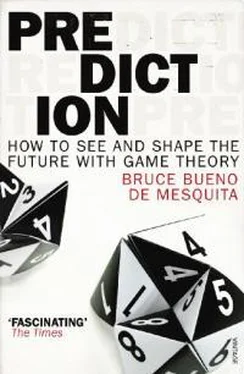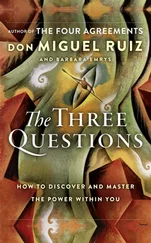This chapter will provide us with a framework for the game theorist’s notions of interests, beliefs, and rationality; a sense of how to use logic to cut through the fog of language; and an understanding of strategic behavior that, in conjunction with the previous two concepts, leads to an ability to better map and anticipate the thinking and actions of others.
WHAT ARE THE OTHER GUY’S INTERESTS AND BELIEFS?
Game theory comes in two primary flavors. Cooperative game theory was invented by John von Neumann and Oskar Morgenstern. 1Their 1947 book on the subject drew a clear and compelling analogy between problems people (or nations) face and parlor games like charades or the name-in-the-hat game, a favorite in my family. These sorts of games deal with players who engage each other, trying to anticipate moves and countermoves, but only in a setting where what they say they will do is the same as what they actually do. That’s why it’s called cooperative game theory—a promise made is a promise kept. Because of this, one big limitation with cooperative game theory, especially in games that involve more than two players, is that it has far too optimistic a view of human nature. In this universe people make deals and keep them. They can be bought off, sure, but once they say they’ll do something, they do it. That means cooperative game theory works fine for zero-sum games where what one side loses equals what the other side wins, but not all that many interesting problems in the world are that cut and dried. When they are not, this original variety of game theory is not nearly as good for my purposes as what has replaced it.
By the early 1950s, the mathematician John Nash, the subject of A Beautiful Mind and the winner of the 1994 Nobel Prize in Economics, invented a different kind of game theory. 2He drew attention to the propensity people have not to cooperate with one another. Poker players and diplomats use polite terms, like “bluffing,” for what ordinary people mean when they say someone is a liar. In noncooperative games, promises do not necessarily mean anything. Lies are a part of strategizing. Promises are kept when a player decides it’s in her interest to do what she promised. When promises and interests differ, people renege, they break their word, they cheat, they do whatever they think will benefit them most. Of course, they know that bluffing and cheating can be costly. Therefore, they take prospective costs as well as benefits into account. In fact, raising costs is one way, albeit a difficult and painful way, of encouraging people to be truthful. Indeed, that is exactly the purpose behind meeting and then raising someone’s bet in poker or calling car dealers instead of going in to see them.
The view of people as cold, ruthless, and self-interested is at the heart of game-theory thinking. There may be room for nice guys, but not much. Most of the time, nice guys really do finish last. Those who will throw themselves on a hand grenade to save their fellows, well, they do so and then, tragically, they are dead. They are out of the game of life. We remember them, we honor them, we extol them, but we just don’t compete with them, because they are not here to compete with us. Such good souls need not occupy much of our time. Or, if they do, we applied game theorists take a cynical view and look for how suicide might benefit them. There might be virgins in heaven, or, as with kamikaze pilots in World War II, Crusaders in the Middle Ages, and some suicide bombers today, there might be significant financial incentives such as cash payments and debt forgiveness to their families in exchange for their sacrifice.
Some may find this materialistic explanation of personal sacrifice offensive. The trouble is, it’s a lot costlier to believe mistakenly in other people’s goodwill than it is to be a cynic and assume they’re looking out for themselves (until and unless their actions say otherwise). It is hard to get burned in personal dealings if you remember Ronald Reagan’s dictum: Trust but verify. For those who are offended by this tough view of human nature, I urge you to consider some facts.
The United States operates the Concerned Local Citizens program in Iraq. Following the alphabet-soup tradition so beloved by the Pentagon, the Iraqis participating in this program are known as CLCs. CLCs help guard neighborhoods against insurgents. They are paid ten dollars a day for their service. It doesn’t seem as if there is anything crass or overly materialistic about that. But then we should pause to ask, who are these CLCs and what, exactly, are we buying for ten dollars a day?
These concerned Iraqis are not your ordinary neighborhood watch group. They are not the folks next door who give school kids a safe place to go when their parents are at work. They are not the friends who have your house key, water your plants, take in your mail, and feed your cat while you’re on vacation. No, they’re former anti-American insurgents, tens of thousands of them. Some of them, in fact, used to belong to al-Qaeda. It would seem that they were among the most fanatic of fanatics, the worst of the worst. And yet for a measly ten bucks a day these supposedly unshakable al-Qaeda terrorists now act like allies of the United States, serving as our very own paramilitaries, helping to keep violence down in mostly Sunni neighborhoods, defending the peace that they used to shatter for a living. How can this be? How can terrorists be so easily converted into our friends and protectors?
As it happens, being an ex-insurgent employed as a CLC is a very good job by Iraqi standards. At ten dollars a day, CLCs can earn a few thousand dollars a year from the United States, plus, of course, whatever extra they make on the side. The average Iraqi, despite that country’s huge oil wealth, earns only about six dollars a day, almost half what a CLC gets! 3Those who think that terrorists are irrational religious zealots who do not respond to monetary and personal incentives should remember that a daily dose of just ten dollars is enough to get such folks to become quasi-friends of the United States of America.
Of course, there is as much room for saints as for sinners in game theory. There’s no problem accommodating the (few) Mother Teresas of our world. Since game theory is about choosing actions given expected costs and benefits, it does encourage us to ask, perhaps obnoxiously, what benefits Mother Teresa might have expected in return for her life of sacrifice and good works. We cannot help but notice that she did not serve the poor as quietly as most nuns do, living out their lives in anonymous obscurity. The very publicness of Mother Teresa’s deeds reassures us of her rationality and her potential to help poor people on a large scale.
Whether we call on the Catholic understanding of a saintly life or the Talmudic view of a charitable life, we encounter a problem on Mother Teresa’s behalf. In doing her good works, she might have had to worry, as (Saint) Bernard of Clairveaux (1090–1153) did, that in obeying God’s commandments as faithfully as possible she could be committing the deadly sin of pride. Maybe she thought herself better than others, more deserving of heaven, even worthy of sainthood, exactly because of her personal sacrifice and good works. That, as we will see, does not seem to have been a major source of worry for her.
From the Talmudic perspective as expressed by Moses Maimonides (1135–1204), she would have had at least as big a problem. Maimonides, or Rambam as he was known in his day, concluded that charity given anonymously to anonymous recipients in order to help them become self-sufficient is the best kind. Mother Teresa’s giving did not rise to this standard, and she made sure it didn’t. She did not give anonymously; she knew to whom she was giving; and she did not strive particularly to make the beneficiaries of her kindness self-sufficient. In fact, she went out of her way to make herself and her acts recognizable. For instance, Mother Teresa carefully promoted herself, creating brand-name recognition—just like Cheerios, Coke, Xerox, or Vaseline—by always wearing the special habit of the order she founded (a white sari with blue trim and sandals) so that she could not be easily confused with just any nice old lady. Of course, anonymous giving could still be prideful, but for sure it could not lead to a Nobel Peace Prize in this world or to beatification and canonization in the next.
Читать дальше











